
Darts - Quick Guide
Darts - Overview
"Aim for the moon if you miss, you will hit a star" − A famous quote by W. Clement Stone often comes into mind when we hear the word Dart
. Dart is nothing but a game of exercising your aim for a definite success that can be achieved through strong focus and rigorous practise.
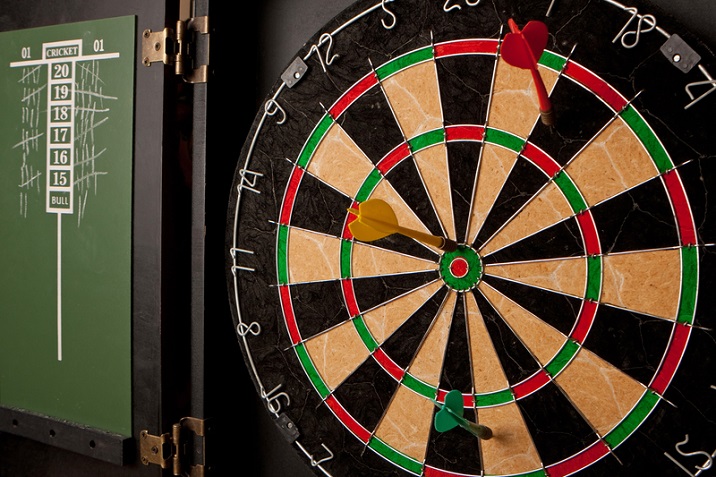
The objective of this game is to throw small missiles (Darts) on to the circular board (Dart board) hanging on the wall. The aim is to hit specific targets. The centre of the dart is known as bulls eye. Previously there were various rules and regulations for this game pertaining to different countries but soon after its popularity, Dart regulation authority (DRA) made specific rules and regulations.
History of Darts
The name of the game "Dart" took place from a French word named "butt" that means target. In earlier days the soldiers used to practice target by throwing short arrows towards the bottom of the tree or the cask. Soon after the drying of the wood it used to create punching spots around there. With the passage of time the wood workers worked upon that and made wood darts to be used in local pubs.
Brian Gamlin, a Lancashire carpenter created the standard numbering plan with a 20 on the top in the year 1896. Apart from Gamlins standard many other standards also emerged but the current set up became very popular for its ability to penalise inaccuracy.
After a number of pitfalls World darts Council, presently known as Professional Dart council (PDC), gave maximum effort to popularise the game.
Participating Countries
World dart federation has 68+ nations under its membership and organizes various matches throughout the year. The list includes countries like Australia, USA, New Zealand, Malaysia, Singapore, Philippines, Honking, Greece, Brazil, Russia etc. Even Asian countries like India and Pakistan also have their active participation in this game.
Dart Organizations
British dart organisations and Professional dart organisations are two official dart bodies. They conduct various tournaments and championships under their governance. Currently as of 8 December 2015, Darius Labanauskas of Lithuania is the no 1 player in the mens ranking of world dart federation. He has a total point of 1048. Similarly Deta Hedman of England tops the womens list with total points of 2022.
Darts - Equipment
A dartboard and a few darts are needed to get started with the game, but these two things have also many subparts that a player should be well acquainted off. Lets have a brief look on them.
Dart Board
A fine quality board consists of sisal fibers or boar bristles and cork. An 18 inch diameter board is divided into 20 sections. Thin metal structures are used to design the dividing lines and with the same materials the numbers are designed. Sometimes the manufactures opt for printing number formats. The board should be positioned on the wall in such a manner that the bulls eye should be 5ft 8 inch above the floor.
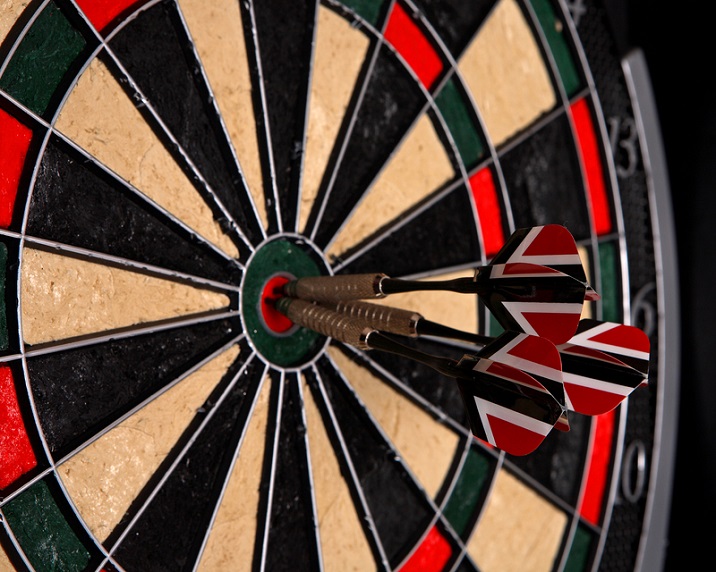
There must be a marking line behind which the player will stand. That line should be at a distance of 7 feet and 9.25 inches from the face of the Dart board. These are the standard distances but rounding off distance is often used by the people in the matches other than tournaments.
The wires and staples that are fixed on the board are known as spiders. They are generally made up of thin steels so a normal dart cannot penetrate them. In case the dart hits the spiders it will bounce back and the player will get no points. To solve this issue many manufactures now days are imprinting these spiders inside the board and some are going for electronic dart board.
In recent years, these electronic dart boards have become more popular. The biggest advantage is that you no need to see the score manually. The sensor will does the duty of that. Earlier electronic boards have the disadvantage of not able to use steel darts on them but now with the advanced technology this problem has reduced.
Precision and accuracy is much needed when it comes to professional competition and here the electronic dart board comes in to the picture more often.
Darts
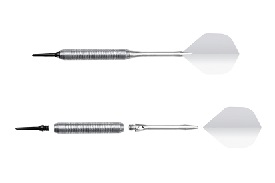
The four main parts of a dart are −
- The point
- The shaft
- The grip
- The flight
These four parts helps the player to handle the dart to get good throwing results. A dart can be made up of either wooden or brass or tungsten. Sometimes Nickel silver type darts are also used. Depending upon your level of comfort you can choose the dart. However; we will also discuss about the process of choosing a dart in this article.
The point
It can be either fixed or movable. The tip is usually soft but can be made up of steel sometimes.
Fixed points are popular, but they often bounce back due to spiders.
The movable point overcomes this disadvantage by retracting itself from the spiders just before its contact.
The back side of the dart is so designed to give necessary momentum to hit the target.
Steel darts provide more sharp teeth than that of the soft tip.
The Shaft
The part of a dart which the player uses to hold before throwing helps the player to get good grip.
The materials used for the construction of the shaft are generally plastic or aluminium or the combination of both.
The biggest disadvantage with plastic is that it produces crack when gets hit with the board very hardly but same is not the case with aluminium which is why aluminium darts cost little bit more than plastics do.
These days, spinning darts are very much popular. They tend to spin while being thrown, to prevent it from getting damaged.
The grip
While throwing the dart, the grip is very much important in giving a hard push.
Better control over the dart comes from better hold and that is what the purpose of grip over here.
Grip design may vary from person to person as they know better which design will make them comfortable while handling a dart.
The Flight
It is nothing but the fin like structure that has been put at the back side of the dart.
It is usually made up of feathers but nowadays, manufactures are putting nylon and polyester materials while designing it.
Flight serves the purpose of giving a perfect drag to the dart so that it can sail smoothly in the air towards its target.
The player should practice with different flights on the dart to know which one suits him better.
Darts - How to play?
Knowledge of Recipe doesnt make a good chef, instead the art of cooking does. Similarly if you know only the scoring methods, then it does not mean you can play well. It requires the techniques and arts of holding, throwing and manipulating the darts so that it will hit the target. Lets learn about some basic things about the game.
Standing Posture
People often neglect about the standing posture but it is the first thing that is going to set the base of your winning chance. Always draw an imaginary line from the bulls eye of the dart towards your line of throwing. Mark it over there with a color. Make sure that you always start throwing your dart from that position only.
Stand with such a posture that there will be a shoulders apart distance between your two feet. The front foot should bear more weight of your body than the back foot. This improves balance and accuracy but too much leaning forward may cause back injuries. So the player is always advised to find his perfect balance spot by rigorous practice.
The position of your arm should be parallel to the ground. Sometimes it varies between 50-90 degrees varying from person to person but the shoulders should stay fixed with respect to other parts of the body.
Gripping Techniques
There is no hard and fast rule about the gripping techniques in dart. The gripping depends upon the two things −
- The barrel of the dart.
- The finger positioning that makes you comfortable.
Other things to be considered are given below −

The tip of your dart should always face up.
The grip should not be so tight that it will make your dart face downward as it will hamper your accuracy.
Your eye should make a straight line between the tip of the dart and your aim before releasing it.
While holding the dart you should not make your grip too tight or too loose.
A relaxing and firm grip is needed. You should hold the dart as if it is a potato chip.
Do not press it hard before releasing.
It is a bad practice to keep your free fingers very close to the dart.
If your free fingers are up in the air, then it reduces the muscle strains on the other fingers.
It is always necessary to find the center of gravity of the dart.
For that you have to place the dart on your palm and with your non-throwing hand slide it towards your fingers to hold it.
Make sure you dont touch the flight or the shaft of the dart.
Throwing Techniques
The art of throwing is the most important aspect in this whole game. Yet most people underestimate this. Without giving a close analysis people throw the darts like throwing stones into the river. Some people lean forward, some go back and forth, some even throw quickly without giving a second thought. Everyones style is unique. Still we should know the basics of it because once your basic is strong it will act as a base upon which you can build the house of techniques of your own that gives you best result.
Alignment is the most important thing 1st you should align in such a manner that your hands, shoulders and elbow remains in a straight line.
Movement of your elbows to much left or right may cause mechanical imbalance. So dont do much deviation.
However; a small variation of elbows may be used depending upon the personal preferences.
Your throwing should be just like swinging a hammer. Use your shoulder for a farm support and use your wrist and hand to boost his speed. While extending your arm makes sure your elbow goes to the optimum height to give necessary kinetic force to the dart. A clear illustrating picture is given below.
At the beginning of the throw it is advisable to hold the dart sideways maintaining the right level. Leaning and swaying is not a good idea. It makes your target not only small but also movable which in turn makes it difficult for you to hit the required target. Seems like, we have gathered some basic knowledge upon throwing darts. Now lets learn some techniques about aiming.
Aiming Techniques
A successful throw depends upon many factors and a good aim tops that list. Aiming has different techniques. Some people use line of sight method which is proved to be helpful in many cases. In this method you can aim the target with either any of the following −
- The first or second knuckle of your throwing hands thumb
- The tip of the dart
- Small finger of the throwing hand
Some people try to aim the target with either right or left eye but this is indeed a lazy practice.
Another best thing that is often advised is to identify your dominant eye. The process of identifying your dominant eye is quite simple. Try to throw the darts at the board by closing each of your eyes separately. Use the eye which you feel difficult to close to get the best results.
Practice Guidelines
The golden lines Practice makes perfect
does apply here also like any other sport. Rather focusing upon practicing for long hours it is good to focus upon the schedule and techniques.
Play your every move as if you are fighting for the final title in a tournament. Always set a particular goal every day. Once you achieve that goal or target, move on to next one without wasting much time on practicing it further because it is the quality that matters not quantity.
Scoring
The whole dart board has been divided in to 20 sections, with points ranging from 1 to 20. Single, double and triple areas are again symbolized within the darts with the help of wires. The darts hitting the corresponding semi-circle decides whether the corresponding point is to be treated as single or double or tripled. The maximum possible highest score that one can obtain here is 180 by hitting the 20 point in the triple semicircle region, known as ton-eighty.
Darts - Variants
This game needs two players to start with. They start from a predefined score, usually 501 or 301 in maximum case. Then with the score that they earn by throwing the dart, deduce it from the predefined score. In every trial the player will be given 3 chances to throw dart. The person, who is able to reduce the score to zero becomes the winner however; there are some other variants of the game. Lets have a look at them.
Double In Double Out
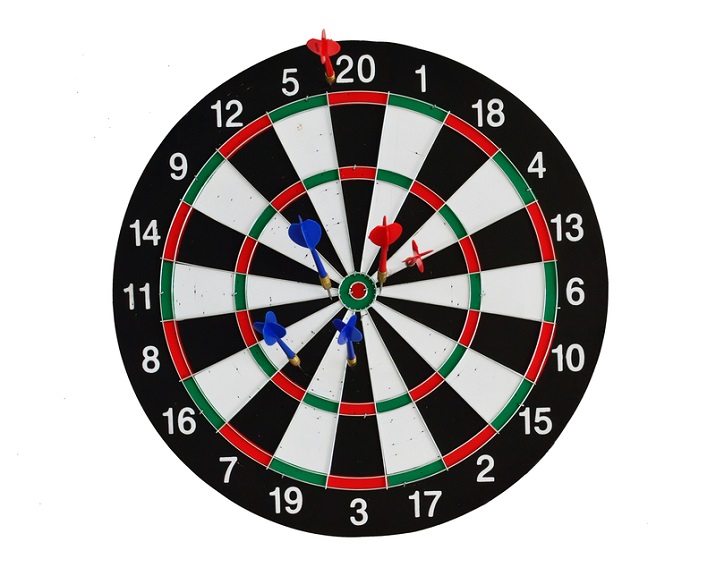
In the professional tournaments, the winning of a leg is decided by the landing of the last dart. It should land in a double or should hit a bulls eye reducing the score to zero at the same moment. Some people also add the rules like- a players score starts getting counted, only after his 1st shot at the double. Until that the hits mean nothing. However; professionals bar themselves from this rule.
Some manipulation of rules is often seen in friendly or armature games. For example, the person who is just behind by 1 point to make it to zero is allowed to hit the dart between the legs of 11. This part is often considered as non-scoring part but here it becomes useful.
Round the Clock
This mode of game is often played by the beginners. The aim is to hit all the parts of the board. The dart should hit each section following a clockwise motion. The end shot should be the bulls eye. It gives a good starting practice for the beginners.
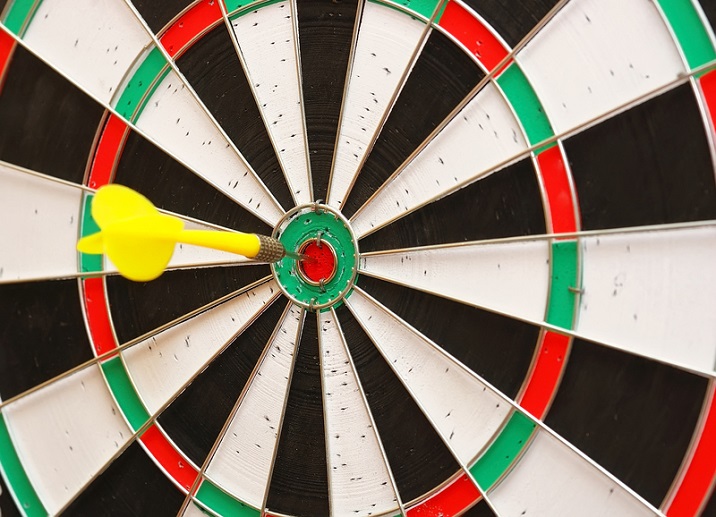
The above picture shows a round the clock hitting format. With a chance of 3, the player has tried to hit the board in clockwise manner, with an attempt to end the game with a bulls eye.
Killer
During the starting of this game the player needs to hit the board with his non-throwing hand. The number his dart hits will be owned by him till the match ends. Now the player needs to increase the lives by hitting his own number as many times as possible till a certain threshold is met.
After the threshold is met they need to hit the other persons number. This process will continue till one dart is left on the board. The winner will be that person whose dart will be on the board till last.
Cricket
It involves hitting of singles, doubles, triples of certain number and bulls eye. The allowed numbers are −
- 15
- 16
- 17
- 18
- 19
- 20
The player needs to hit these numbers. There is no particular order of hitting though. At the end he should have a calculative score where he must have hit all the parameters three times at least. Winner is the person who finishes the above target faster.
Darts - Performance Tips
Knowing the rules and regulations is not going to help to win every match. To have a cutting edge over others you should do the things differently rather doing different things. Often the tips of the senior players come handy while playing in a match. Lets discuss some of them.
Consistency
Hitting with right consistency is certainly going to award you with the level of confidence more than others. Before throwing, position your feet properly with elbow pointing towards your target and keep the dart always pointing towards up not down.

Some suggests building a muscle memory approach. This means hitting the same target always keeping in mind that the hitting of 2nd dart is going to follow the 1st dart.
Choice of Right Dart

Many varieties of darts are available in the market. For example one can get a dart made up of either wooden or silver or nickel etc. but tungsten darts are more popular for their small barrels and high resistance to wear and tear.
The general range of weight of the darts lays in between 12 gm to 50 gm. Everyones comfortable zone is not same. So it is a general piece of advice to visit a local shop and try out every possible darts of different weights till you become sure about the weight factor.
Memorize Your Outnumbers
Remembering the dart sequence is the most difficult thing that most of the players struggle about.
So the solution is always try to subtract a ton which is otherwise known as 100 from your out-number and check whether the left number is one dart out that you like.
This method is often helpful and is used by many to remember their out numbers. So try it while practicing.
Darts - Tournaments & Champions
Tournaments
Organizations like BDO and PDC are responsible for running World professional championships. Every year during the period of Christmas and New Year the championship is arranged.
PDC championship is organized every year prior to the BDC championship. Some major dart tournaments are −
- PDC world championship
- PDC Premier league
- WDF world cup
- BDC world masters Championship
- World grand pix
- Grand slams of darts
Darts Champions
Phil Taylor
Popularly known as the best dart player in the world, Phil Taylor has a record of 16 world championships. He has 83 major titles. In addition, he has won PDC player of the year 6 times. In PDC order of merit, his rank is 3.
Trina Gulliver
Known as the golden girl of darts, she has a record of 9 time womens world professional championship under BDO. She won her first title in 2001 against Mandy Solomon by beating her in 2-1. She has the eight highest winning 3 dart averages in the Women's World Championship including 3 winning average higher than 90.
Eric Bristow
He is known as The crafty Cockney. Eric has won 5 world championships and world Masters Titles. He continued to be at rank 1 during the periods 1980-81, 1983-85 and 1990. Currently he is working as commenter on sky sports data coverage.